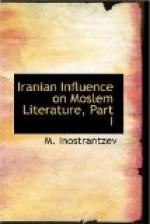[Footnote 2: See my studies on the Ain-Nameh.]
[Footnote 3: See my book on Materials from Arabic Sources for Culture History of Sasanian Persia.]
[Footnote 4: Fihrist 315.]
A different kind of importance attaches to histories devoted to government and national life of the Sasanian period and to the epic and literary tradition of Persia. Their value as history has been acknowledged and appreciated by the progressive circles of the Musalman community. Contemporary researches directing the greatest attention to this aspect of Iranian movement appreciated its value and thanks to their works, we are enabled to speak with some clearness regarding books of exceeding importance. Traces of ancient Iranian epic tradition are observable in some Greek writers, Ktesias, Herodotus, Elian, Charen of Mytelene and Atheneus. But it has survived in a considerable quantity in the Avesta.[1]
[Footnote 1: The principal works for investigating the Persian historical and literary tradition are, besides the introduction to his edition and translation of the Shah-Nameh by Mohl, Noeldeke’s German History of the Persians, and Arabs at the time of the Sasanians, his introduction, and his Iranian national epic G.I.Ph. II, 130—212; Baron Rosen, On the question of the Arabic translations of the Khudai Nameh (Paraphrase by Kirst in W.Z.K.M.X, 1896); H. Zotenberg, History of the Kings of Persia by Al-Thalibi, Arabic text with translation, especially Preface, XLI-XLIV. A number of profound ideas and ingenious suggestions are made in the various articles and reviews by Gutschmid. (See Appendix V, p. 141).]
The most recent and pregnant exposition is by Lehmann.
It existed also in official writings of the Sasanian times, recensions of which, we possess in several Arab histories and in the Shah Nameh. Like the scientific literature these writings were subjected to a final redaction towards the close of the Sasanian dynasty and it is this recension that has mainly come down to posterity. Alongside of official writings of a general character, there existed various books of epic-historical contents, for instance, the Yadkari-Zariran.[1] As in these writings, so in the versions appearing from them at later times, the materials embodied were of a kindred nature, like the Romance of Behram Chobin, Story of Behram Gor, the narrative of the introduction into Persia of the Game of Chess. Besides these there were writings relating to local histories. It is noteworthy that the epic element was and is preserved with persistence by the Parsis. Mohl notes that the majority of Persian epic poems, excepting the Shah Nameh, has been preserved only in manuscripts belonging to Parsis[2]. Farther development of this phase of Persian literary tradition bifurcated into two directions. It has been shown that the official chronicles of the Sasanian times exercised influence on the development of the Musalman science




